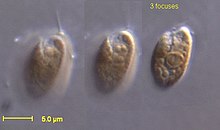Cryptomonada
| Cryptomonada | |
|---|---|

| |
| Rhodomonas salina | |
| Scientific classification | |
| Domain: | |
| Phylum: | |
| Subphylum: | |
| Superclass: | Cryptomonada Cavalier-Smith, 2004
|
| Classes & orders | |
Cryptomonada is a proposed super-class of Cryptists linking Cryptophyceae and Goniomonadea, which was first proposed by Cavalier-Smith in 2004. He made this proposal based on three shared morphological characteristics: Presence of a periplast, ejectisomes with secondary scroll, and mitochondrial cristae with flat tubules.[1]
Genetic studies as early as 1994 also supported the hypothesis that Goniomonas was sister to Cryptophyceae.[2] A study in 2018 found strong evidence that the common ancestor of Cryptomonada was an autotrophic protist.[3]
References[edit]
- ^ Cavalier-Smith, Thomas (2004). Organelles, Genomes, and Eukaryote Phylogeny. pp. 87–88.
- ^ McFadden, Gilson, & Hill (1994), "Goniomonas: rRNA sequences indicate that this phagotrophic flagellate is a close relative of the host component of cryptomonads", European Journal of Phycology, 29 (1): 29–32, doi:10.1080/09670269400650451
{{citation}}: CS1 maint: multiple names: authors list (link) - ^ Cenci (2018), "Nuclear genome sequence of the plastid-lacking cryptomonad Goniomonas avonlea provides insights into the evolution of secondary plastids", BMC Biology, 16 (1): 137, doi:10.1186/s12915-018-0593-5, PMC 6260743, PMID 30482201
